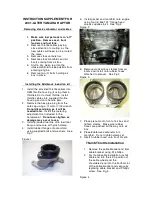
Active Distance Assist DISTRONIC
Function of Active Distance Assist
DISTRONIC
Active Distance Assist DISTRONIC maintains the
set speed on free-flowing roads. If vehicles in
front are detected, the set distance is main‐
tained, if necessary, until the vehicle comes to a
halt. The vehicle accelerates or brakes depend‐
ing on the distance to the vehicle in front and
the set speed. The speed (in the range between
15 mph (20 km/h) and 130 mph (210 km/h))
and the distance to the vehicle in front are set
and saved on the steering wheel.
Other features of Active Distance Assist
DISTRONIC:
R
Adjusts the driving style depending on the
selected drive program (fuel-saving, comfort‐
able or dynamic) (
→
page 175)
R
Reacts to stationary vehicles detected in
urban speed ranges (except bicycles and
motorcycles)
R
Initiates acceleration to the stored speed if
the turn signal indicator is switched on to
change to the overtaking lane.
R
Takes one-sided overtaking restrictions into
account on highways or on multi-lane roads
with separate roadways (country-dependent).
Vehicles with Active Parking Assist: if the
vehicle has been braked to a standstill on multi-
lane, separate roadways by Active Distance
Assist DISTRONIC, it can automatically follow
the vehicle in front driving off again within
30 seconds. If a critical situation is detected
when driving off, a visual and acoustic warning is
given indicating that the driver must now take
control of the vehicle. The vehicle is not acceler‐
ated any further.
Active Distance Assist DISTRONIC is only an aid.
The driver is responsible for keeping a safe dis‐
tance to the vehicle in front, for vehicle speed
and for braking in good time.
System limitations
The system may be impaired or may not function
in the following instances:
R
In snow, rain, fog, heavy spray, if there is
glare, in direct sunlight or in greatly varying
ambient light.
R
The windshield in the area of the camera is
dirty, fogged up, damaged or covered.
R
If the radar sensors are dirty or covered.
R
In parking garages or on roads with steep
uphill or downhill gradients.
R
If there are narrow vehicles in front, such as
bicycles or motorcycles.
In addition, on slippery roads, braking or accel‐
erating can cause one or several wheels to lose
traction and the vehicle could then skid.
Do not use Active Distance Assist DISTRONIC in
these situations.
Driving and parking 203
















































